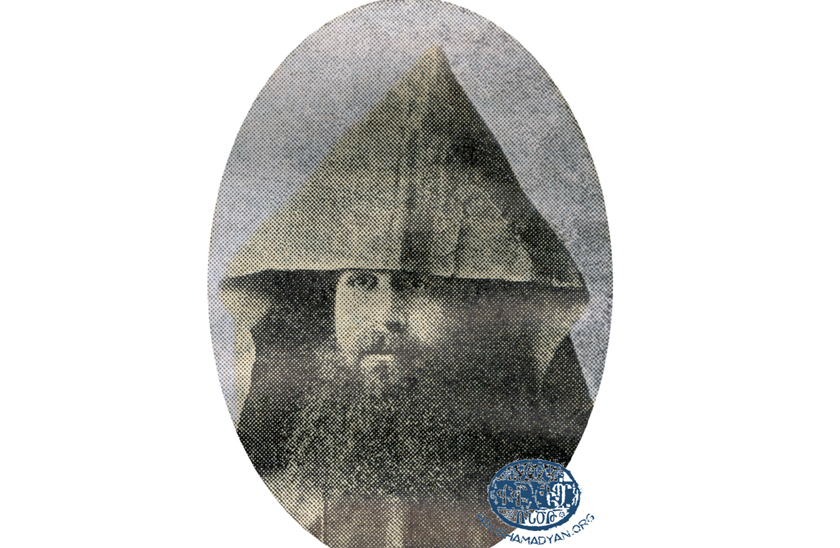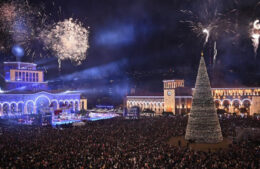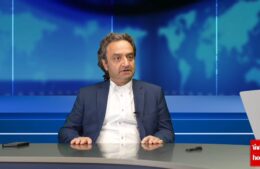The Great Loss of the Armenian Clergy During the Armenian Genocide – Very Reverend Father Ardavazt Kalenderian
- (0)

By Archbishop Papken Tcharian
The series of articles, which will be presented to our readers, are written by Archbishop Papken Tcharian, and translated by Tamar Topjian Der-Ohannessian.
The book, “The Great Loss of the Armenian Clergy during the Armenian Genocide” was published in 2009, by the generous donation of Mr. and Mrs. Levon and Tamar Der-Ohannessian.
The articles which will be featured in the coming days, are from the doctoral thesis of Archbishop Tcharian, and it is dedicated to the 90th anniversary of the martyrs of the Armenian Genocide.
In his thesis, Tcharian writes, “The enemy, in his cruelty, ruthless and unjust, did not discriminate. He slaughtered the students of Maghakia Ormanian, Yeghishe Tourian and Mekhitar Sepasdatsi, the promising seminarians of Armash and St. Ghazar, who were the true intellectual clergymen, and who shared the fate of their people and their parishes.”
“The catastrophe of April 1915 was a fatal gash in the heart of the Armenian Apostolic Church. Despite of it all, however, the Armenian people and the Armenian Church experienced a new renaissance. … We do not hesitate to call all those clergymen who were massacred during the Genocide of April 1915 martyrs and saints.”
—————————————————
V. Rev. Fr. Ardavazt Kalenderian was born in 1876, in the village of Yenidjé in Broussa. His baptismal name was Yeprem. In 1896 he entered Armash Seminary and was taught by Bishop Yeghishé Tourian and V. Rev. Fr. Torkom Koushagian.
He was ordained celibate priest by Bishop Yeghishé Tourian. Arch. Maghakia Ormanian has said in his autobiography: “… A survivor of the class scattered during the time of catastrophe, and one of the students ordained by Tourian.”
He was elected diocesan vicar to the diocese of Yerzenga for the period of 1902-7. Yerzenga became one of his favorite places and he worked hard for five years for the improvement and progress of that diocese. One of his close friends, K. Kabbenjian, made the following note about his tenure as a diocesan vicar:
…He had come to the seminary of Armash from Yerzenga, for a short period of relaxation, but the onus of responsibility on his shoulders had already summoned him to the diocesan office of Tokat, which he had accepted with pleasure. Yerzenga was his preferred place, where he had worked hard for years, contributing to its advancement. He had fond memories from that city, with a large Armenian population, and he had just started feeling content, when one day he had to leave the city with tears in his eyes, just to appease the ambitious delusions of one V. Rev. Fr. Emmanuel, a priest newly converted from Roman Catholicism, and a favorite of the patriarch.
So, V. Rev. Fr. Ardavazt left Yerzenga and came to Yevtogia (Tokat) assuming the office of diocesan locum tenens. The city of Yevtogia was under the jurisdiction of Sepasdia. It had gotten its name from the mother of Theotos Caesar, Yetoksia. In those days the diocese of Yevtogia had more than twenty churches and a cathedral, St. Asdvadzadzin (Mother of God), which was the seat of the prelate. It had a large Armenian community active in the national, ecclesiastical and cultural fields. However, V. Rev. Fr. Ardavazt’s career as diocesan locum tenens did not last long. According to another testimonial from his friend, K. Kabbenjian,
…His career in Tokat was shortlived and that was to be expected. Tokat was one of those Armenian centers where church and national/cultural affairs were very highly developed and had their difficult and complicated facets. The enthusiastic and unrelenting personality of V. Rev. Fr. Ardavazt was more suited to a completely uncultured and unrefined environment such as the remote and dark Edessa.
- Rev. Fr. Ardavazt departed from Yevtogia, leaving his office as locum tenens, and assumed a more responsible position.
In 1911 he went to the diocese of Edessa as an elected prelate, and worked there to his dying day… until 1915.
When the Ottoman Constitution was declared, the diocese of Edessa (Ourfa) did not have a prelate. In the end of 1907 V. Rev. Fr. Anania Hazarabedian left for Constantinople. V. Rev. Fr. Paren Melkonian came to Edessa as a patriarchal inspector, but left before the declaration of the Constitution, and the post of diocesan vicar was assumed by Rev. Fr. Khatcher.
After 1910, the local Representative Assembly elected V. Rev. Fr. Ardavazt as its prelate, in accordance with the Ottoman Constitution.
By the election of V. Rev. Fr. Ardavazt, Ourfa (Edessa) acquired its deserving prelate. All the national, ecclesiastical, educational, cultural and political affairs of the diocese entered their proper courses. The economic situation of the prelacy improved gradually. Each and every Armenian in Ourfa was filled with fresh revolutionary ideas. The people armed themselves for self-defense. Turkish sharqi songs were replaced by Armenian revolutionary songs, which were sung with great enthusiasm by young and old alike. The youth and adolescents read the nationalistic novels of Raffi and Aharonian with great absorption.
- Rev. Fr. Ardavazt gave great importance to the educational programs. Talented teachers were invited from Constantinople and Kharpert to teach in the schools.
The V. Rev. Father improved musical instruction in the schools, which appealed greatly to the music-loving Armenians of Ourfa. After some time the musical and artistic taste of the people was refined, and Gomidas became the favorite of everyone. A talented student body emerged, educated with the new revolutionary inspiration of freedom.
- Rev. Fr. Ardavazt created great enthusiasm and passion in his diocese. He converted the barren land into a flowering garden. He quickly established amicable relations with the government and the political leaders, and won the affection of the people.
As a well deserved reward for all this work, he received the recommendation from the Representative Assembly to become a bishop, but did not attain this rank due to the prevailing circumstances.
I would like to include here the following lines written by a close friend of his as a token of his sincere affection:
It was the sincere and close friendship between us that urged me in 1910 to recommend him to the Representative Assembly of Edessa after the boisterous leadership of V. Rev. Fr. Anania Hazarabedian, which had greatly occupied the press and the patriarchate. The diocese needed an enthusiastic, educated and active priest. V. Rev. Fr. Ardavazt was the most suitable man for such a backward city with such a vast opportunity for work.
The Representative Assembly of Edessa, leaving the sad past behind, had made the best choice in the person of V. Rev. Fr. Ardavazt, who was already on duty by 1911. This was to end not only with his death, but with the total extermination of all the Armenians living in this old, historical city.
From the beginning, this devoted and selfless clergyman showed a loving and passionate enthusiasm, and an indefatigable willpower. The field of work stretching in front of him was barren and unrefined. The unformed and chaotic national, ecclesiastical and educational life had demeaned and degraded the local Armenian community. V. Rev. Fr. Ardavazt was able to secure the deep affection of his parish by cultivating a kind and friendly relationship with the local government and the neighboring people in a very short period of time. This led the parish members to recommend him for the rank of bishop, for which this distinguished clergyman was so worthy. But the ensuing unfavorable circumstances did not let him achieve this venerable rank.
During his four-year tenure (1911-1915) he succeeded in enhancing and improving the church. He organized a regular church choir. With his own private efforts, he had two beautiful schools built for boys and girls, the ruins of which stand today more prominently than his own unknown grave.
Because of the onset of World War I, this renaissance, resurgence and the zeal to live a free life that the Armenians of Ourfa were experiencing did not last very long. Soon, the implementation of the Turkish government’s plan for the extermination of the Armenians began.
The Ottoman Empire, under the pretext of gathering ‘Military Aid’ began looting and appropriating all the wealth of the prominent merchants and artisans.
According to the eyewitness report of Archpriest Fr. Kassabian, “… all the wealth of the Armenians was being looted by the government. People paid with Ottoman gold-coins and still would not be spared. All these payments were made in Ottoman gold coins.”
While still in this predicament, the Armenians of Ourfa got news of arrests in Constantinople. Ourfa became the first station for the deportees from Zeytoun.
The Armenians of Ourfa, each in his or her capacity, rushed to the rescue of the bedraggled, robbed and naked refugees from Zeytoun.
- Rev. Fr. Ardavazt kept making requests to the government to improve the predicament of the refugees, but unfortunately his requests were unanswered.
Then it was the turn of the Armenians of Ourfa. They were subjected to violent massacres on the hands of the Turkish government. Widespread arrests began on May 27th 1915. First, the government arrested the intellectuals and the members of the leadership.
After these arrests, the local national leadership had a meeting in the prelacy to assess the situation and to act accordingly. The V. Rev. Father clarified the situation and then reported the result of his appeals. The meeting decided to revolt and resort to self-defence in case of further arrests. The prelate and some political-party members agreed with this decision, but some conservative members refused this course of action, and decided to allocate a sum of money to the priest to bribe the government officials whenever necessary.
During the meeting, the renowned revolutionary activist of Ourfa, Megerditch Yotnaghperian, unexpectedly barged into the hall. When he heard the decision of the council he got very angry and expressed his dismay about the fact that our people followed the advice of spineless and submissive men. He also proclaimed that he would stay in hiding and would not allow the Armenians of Ourfa to be deported.
Soon, the government started military conscription and a large number of young men were taken outside the city ‘allegedly to be put to work’. After the order for conscription, all the efforts and sermons of the religious and national leaders advised the people to be vigilant and to obey the orders of the government.
But the youth, who were brought up with revolutionary spirit, banded together and prepared for self-defense. The massacres of 1895 in Ourfa had taught them an important lesson.
Gradually, the Armenians of Ourfa were deprived of their leaders, except the prelate, V. Rev. Fr. Ardavazt Kalenderian, who was their only hope. The V. Rev. Father worked day and night to secure the release of the prisoners, but did not succeed.
On July 10th the gubernatorial leadership summoned the priest and demanded all the weapons to be collected within 48 hours. V. Rev. Fr. Ardavazt immediately returned to the prelacy and sent the message to the revolutionary hero, Megerditch Yotnaghperian, informing him of the stern demands from the government. Meanwhile, just to have obeyed the government’s directive, he sent Father Katcher to gather the people in the church, where he told them about the orders. But the people, led by the revolutionary heroes, kept their best weapons, and brought only a few broken guns to the courtyard of the church.
The authorities were furious because their plan for seizing the weapons had failed.
Finally, it was the prelate’s turn. He was invited by the government and proceeded to join the prisoners…
On July 26th V. Rev. Fr. Ardavazt was invited to the municipality building for the last time. He seemed to have a premonition that this was going to be the last time he was leaving the prelacy, so he entered the cathedral, knelt in front of the altar, then looked at the school buildings he had helped built with tears in his eyes, embraced the priests and left for the municipality building.
The premonition of the priest came true. They led him straight to jail. He joined the hundreds of prisoners who had been living the horrors of a Turkish jail for the past month.
A young adolescent boy, Kassabian – now a married priest in San Paulo – who witnessed the departure of the reverend father from the prelacy, described it as follows:
… We were standing around in the courtyard of the cathedral, when V. Rev. Fr. Ardavazt descended from the stairs of the prelacy accompanied by policemen.
His face was pale and his eyes had a tired expression. Before leaving, he entered the church, knelt in front of the altar and prayed for a long time. When he came out, tears were streaming down his cheeks. We approached our beloved teacher and kissed his hand. At that moment, I raised my voice with confidence and said: “Reverend Father, where are you going? How can you leave us behind, like orphans?” Instead of an answer, the priest blessed us and left for good with the waiting policemen.
The Turkish government started carrying out its plans of extermination. There were arrests, looting and massacres everwhere… But the heroic Armenian revolutionaries of Ourfa, led by Megerditch Yotnaghperian, rebelled and resorted to self-defense. They fought behind barricades for twenty- five days. Suddenly, a German messenger sent a request to meet with Megerditch Yotnaghperian. A short ceasefire ensued when the German visited Megerditch. First, the messenger praised the resistance. Then he advised him to stop the fighting and promised to give him safe passage to Germany. Megerditch, the heroic revolutionary answered enraged: “If you have a sense of civilized and Christian men, save the innocent Armenian people being massacred in the desserts. Tell us! Where are our leaders? What happened to our prelate? Just return V. Rev. Fr. Ardavazt to us, and I will immediately put down my arms.”
On October 23rd 1915 the heroic city finally fell under the brutal onslaught from the Ottoman government. The prelate of the diocese, V. Rev. Fr. Ardavazt Kalenderian, the leaders and intellectuals, and everyone, from the humblest artisan to the most heroic revolutionary were martyred. They all knew how to be martyred with pride for the sake of their fatherland.
From the book “Hayasdan”, 1914-1918, of M. Arzoumanian, we read the following information about the martyrdom of V. Rev. Fr. Ardavazt:
…Krikor Zohrab and Vartkes (Hovhannes Serenkulian) were arrested and were being accused of ‘crimes against the authorities’. They had to ‘appear’ at the military courthouse of Dikranagerd. They were taken to Ourfa via Adana and Aleppo and were thrown in jail. From there, these two, along with the prelate of Edessa, V. Rev. Fr. Ardavazt Kalenderian, and two other activists were taken in carriages to a place called Garakerprou, about one hour away from Ourfa. Armed chetes, led by Cherkez Ahmeti and the murderer Khalili, Enver’s uncle, were standing there at the ready. They arranged for the guards accompanying the prisoners to return, having fulfilled their responsibility. Immediately thereafter, they attacked the defenseless Armenians, plucked the beard of V. Rev. Fr. Ardavazt, dismembered the others, subjected them to unspeakable torture and then beheaded them all…
Thus, he fell as an ‘innocent dove’ under the sword of the enemy.
***
- Rev. Fr. Ardavazt Kalenderian loved literature and poetry. “He was more of an expert of art than a writer, and the booklet he published, called ‘Sarsourner’ (Tremors) is a testimony of a musician’s bright talent and disposition. Armenian music had a lot to expect from this creative clergyman so intent on improving the church music.”
Many poems written by him have been published in papers such as ‘Dadjar Shapatatert’ and ‘Louys Shapatatert’.
A LIST OF HIS LITERARY WORKS
- ‘Mioutian Baraka yev Shenorhali’ (The Case of Unity and Shenorhali). His doctoral thesis. A volume modest in magnitude and content, published in a special volume in the Nerso-Srabian printing house of Marzvan.
- ‘Sarsourner’ (Tremors). A musical booklet which is a testimony of a musician’s bright talent and disposition.
- ‘Viravor Dadrag’ (Wounded Dove), a poem.
- A letter addressed to Effendi P. Donigian titled: ‘Ermeni Kilisase ve Ermeni Milleyeti’’ (The Armenian Church and the Armenian People).
- ‘Hay Azke yev Hay Yegeghetsin’ (The Armenian Nation and the Armenian Church), an article.
- ‘Pokhatartse’ (The Reciprocation), a poem.
- ‘Gateel me Tchour’ (A Drop of Water), a poem.
- ‘Khorhourtnerous Anourchkin Metch’ (In the Reverie of my Thoughts), a poem.
- ‘Kheghjmedoutian Pajhine’ (The Share of Conscience), a poem.
- ‘Arevin Tem’ (Facing the Sun), a poem.
- ‘Aghotk’ (Prayer), a poem.


















